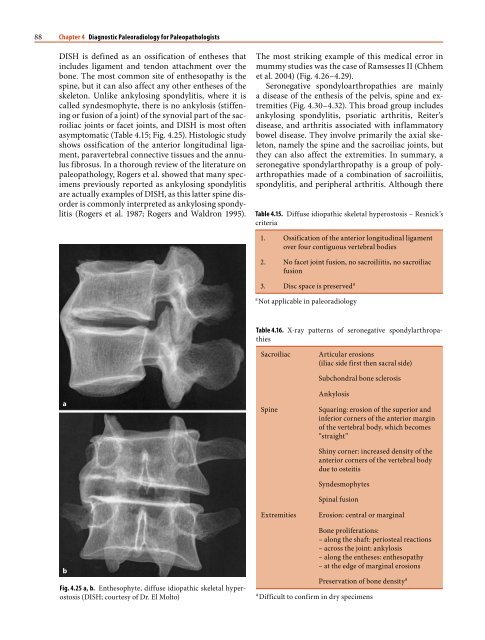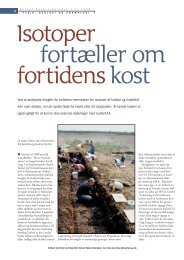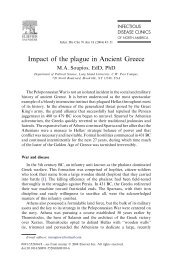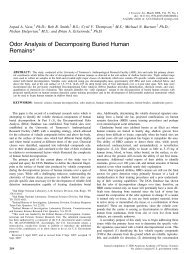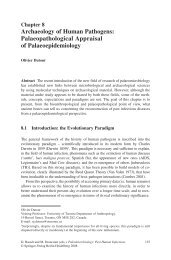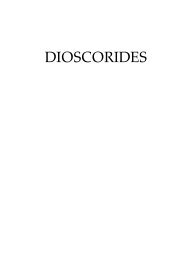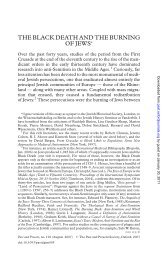1 Paleoradiology: History and New Developments - Academia.dk
1 Paleoradiology: History and New Developments - Academia.dk
1 Paleoradiology: History and New Developments - Academia.dk
Create successful ePaper yourself
Turn your PDF publications into a flip-book with our unique Google optimized e-Paper software.
edge of the x-ray film, respectively. A positive angulation<br />
of the central ray of the x-ray beam means that<br />
the x-ray cone is situated above the occlusal plane <strong>and</strong><br />
angled downward toward the teeth. A negative angulation<br />
means the x-ray cone is situated below the occlusal<br />
plane <strong>and</strong> angled upward toward the teeth.<br />
True Maxillary Occlusal (Vertex View)<br />
The value of this radiograph in evaluation of the dental<br />
assessment is minimal in situations where all the<br />
teeth are erupted, but can be useful in assessing the<br />
position of unerupted <strong>and</strong> impacted teeth in the maxilla.<br />
It is also a useful view for assessing the buccal<br />
cortex of the maxilla (Fig. 2.38).<br />
True M<strong>and</strong>ibular Occlusal<br />
The true m<strong>and</strong>ibular occlusal view (Fig. 2.39) will be<br />
useful in evaluating the buccal <strong>and</strong> lingual cortices of<br />
the m<strong>and</strong>ible as well as the position of unerupted teeth<br />
<strong>and</strong> impacted teeth. In patients, this radiograph is often<br />
used to assess the soft tissue of the floor of the mouth<br />
where calcifications within the subm<strong>and</strong>ibular salivary<br />
gl<strong>and</strong> duct can be observed radiographically. Usually,<br />
the film is placed so that the long axis of the film is<br />
bisected by the midsagittal plane. However, in some<br />
cases it is desirable to place the long axis of the film anteroposteriorly<br />
<strong>and</strong> image the left <strong>and</strong> right sides using<br />
separate films. This is particularly true when disease is<br />
present that has exp<strong>and</strong>ed the buccal cortex.<br />
The next three views are best thought of as large<br />
format, periapical radiographs using a bisecting angle<br />
technique. These views are particularly useful when<br />
the anatomy <strong>and</strong> bone surrounding the teeth is of<br />
interest <strong>and</strong> a larger coverage area is desired. These<br />
films are also useful in situations when the maxilla<br />
<strong>and</strong> m<strong>and</strong>ible are articulated <strong>and</strong> opening is limited.<br />
Anterior Maxillary Occlusal<br />
This view (Fig. 2.40a) can be used to assess the location<br />
of impacted canines <strong>and</strong> posterior teeth as well as<br />
assess the maxillary buccal cortex. The x-ray beam is<br />
typically angled at +65 º to the occlusal plane.<br />
Lateral Maxillary Occlusal<br />
This view (Fig. 2.40b) can be used to localize impacted<br />
teeth in the anterior maxilla as well as assess the<br />
alveolar process <strong>and</strong> maxillary sinus. The x-ray beam<br />
is angled +60 º to the occlusal plane.<br />
Anterior M<strong>and</strong>ibular Occlusal<br />
This view (Fig. 2.41) is similar to the anterior m<strong>and</strong>ibular<br />
periapical view, but provides an image of the<br />
entire tooth <strong>and</strong> anterior m<strong>and</strong>ible. The x-ray beam is<br />
angled – 55 º to the occlusal plane.<br />
2.8.3<br />
Specimen Imaging<br />
2.8.3.1<br />
Imaging Intact Jaws<br />
2.8. Dental Radiology<br />
Fig. 2.37. Periapical radiography.<br />
Red rope wax<br />
on a Styrofoam holder to<br />
stabilize the film <strong>and</strong> holder<br />
in position. Modeling putty<br />
can be used to position <strong>and</strong><br />
stabilize the jaw<br />
Dental imaging will usually involve periapical <strong>and</strong><br />
occlusal views. Periapical views will use size-1 film<br />
37


